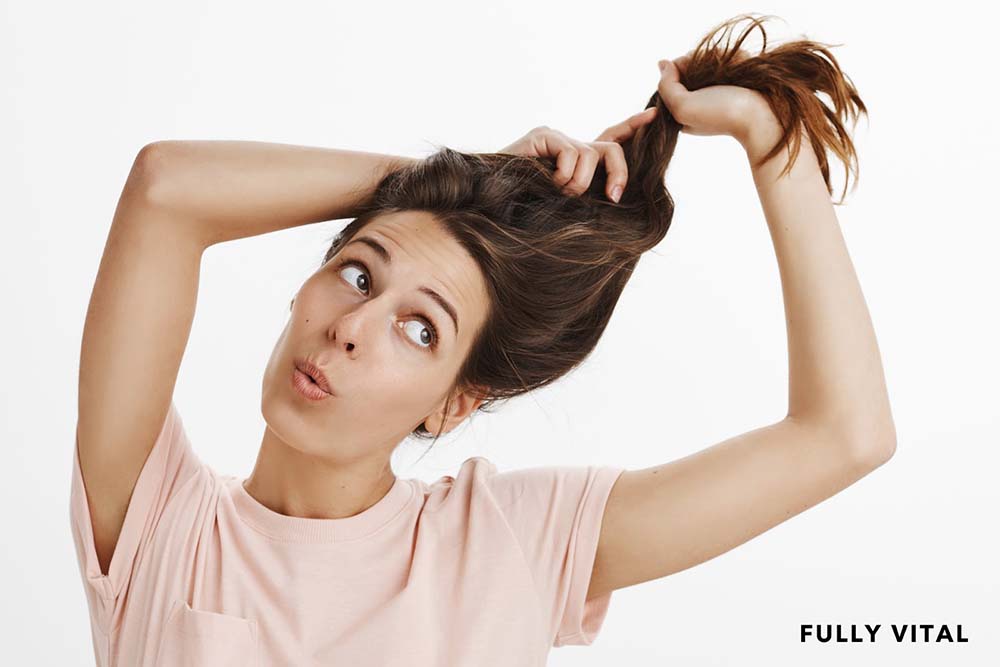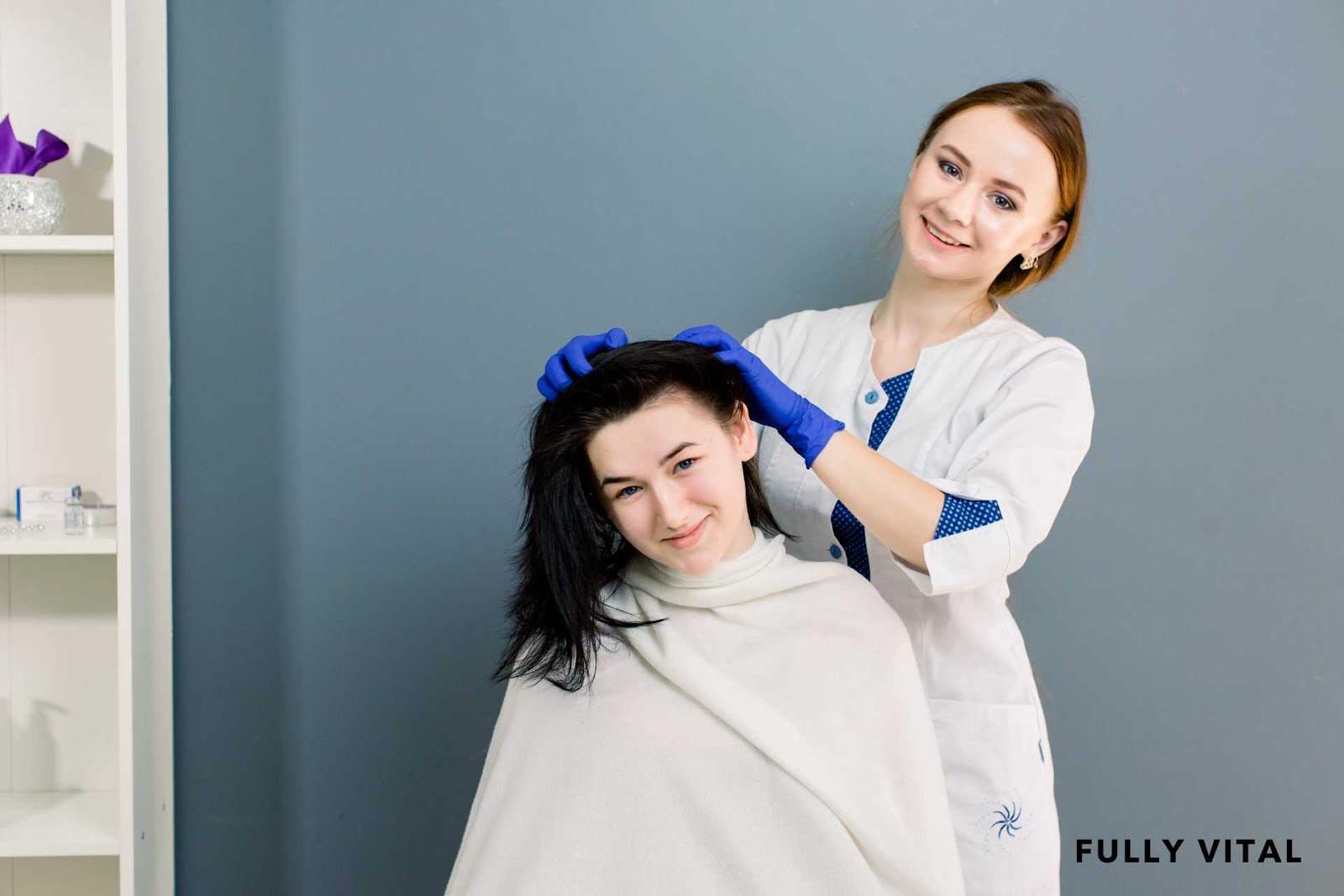
Trichotillomania: Understanding and Addressing Hair-Pulling Disorder
Trichotillomania is a hair-pulling disorder that can affect anyone, but it is particularly important for women of all hair types seeking hair growth solutions to be aware of this condition.
In this article, we will explore what trichotillomania is, its causes, why awareness is crucial, how it works, its downsides, alternative solutions, and practical tips to manage the condition.
Let's delve deeper into this topic!

I LOVE MY HAIR NOW
FullyVital hair serum and hair vitamins made tremendous improvements in my hair. I truly love my hair now.
Dorit S.,
What Is Trichotillomania?
Trichotillomania is classified as a body-focused repetitive behavior (BFRB) disorder, characterized by the recurrent and irresistible urge to pull out hair, often resulting in noticeable hair loss and bald patches.1
The condition is challenging to control, and individuals affected may feel embarrassed and distressed about their hair-pulling habits.
What Causes Trichotillomania?
The exact cause of trichotillomania remains unclear, but research suggests a combination of genetic, environmental, and psychological factors play a role.
Some studies indicate that imbalances in brain chemicals, particularly serotonin, may contribute to the development of this disorder.2

Why Is Trichotillomania Awareness Important?
Spreading awareness about trichotillomania holds significant importance for several reasons.
The reasons can be highlighted as follows:
-
Recognition of the Condition: A large number of individuals affected by trichotillomania are often unaware that their pattern of hair-pulling behavior is, in fact, a recognized medical condition. By raising awareness, it becomes possible to assure them that they're not alone and there are, indeed, effective treatments available.
-
Combating Stigma: Increased awareness is crucial to fight the stigma commonly associated with trichotillomania. Contrary to some misconceptions, trichotillomania is not just a simple habit or indicative of a lack of willpower. It's a legitimate medical condition that necessitates understanding, compassion, and supportive measures.
-
Encouragement of Resources and Research: When society becomes more informed about trichotillomania, it paves the way for additional resources and research efforts to be dedicated to discovering improved treatment options. This can lead to a significant enhancement in the quality of life for individuals living with the disorder.
How Does Trichotillomania Work?
Trichotillomania involves a cycle of tension, hair-pulling, and relief.
Individuals may experience mounting tension or anxiety, which triggers the urge to pull their hair.3
Pulling provides a temporary sense of relief or pleasure, leading to reinforcement of the behavior.
However, feelings of guilt and distress often follow, perpetuating the cycle.
What Are The Downsides Of Trichotillomania?
Trichotillomania can have several adverse effects on an individual's physical and emotional well-being.
Some of these downsides include:
Physiological Consequences:
-
Scalp irritation and inflammation due to repetitive pulling
-
Permanent hair loss and thinning in the affected areas
-
An increased risk of infection and scarring
Emotional and Psychological Consequences:
-
Feelings of shame, embarrassment, and isolation
-
Anxiety and depression resulting from the inability to control the hair-pulling urges
-
Negative impact on self-esteem and body image, leading to social withdrawal
What Are The Alternative Solutions To Trichotillomania?
Addressing trichotillomania requires a multifaceted approach.
Here are some alternative solutions that can help:
Behavioral Therapy
Cognitive Behavioral Therapy (CBT) is considered one of the most effective treatments for trichotillomania.
It focuses on identifying triggers and implementing strategies to interrupt the hair-pulling habit.
Support Groups
Joining support groups or online communities can provide valuable emotional support and a sense of belonging to individuals struggling with trichotillomania.
Sharing experiences and coping strategies with others can be incredibly empowering.
Habit Reversal Training (HRT)
Habit Reversal Training is a behavioral therapy technique that aims to replace hair-pulling with alternative behaviors whenever the urge arises.
This can disrupt the habitual cycle and gradually reduce hair-pulling tendencies.
Stress Management Techniques
Learning stress management techniques such as meditation, yoga, or deep breathing exercises can be beneficial in reducing tension and anxiety, which are common triggers for hair-pulling episodes.
Hair Growth Products
For those dealing with hair loss caused by trichotillomania, using hair growth products can be a helpful part of the recovery process.
Products specifically formulated to stimulate hair growth can aid in restoring hair in affected areas.
Practical Tips to Manage Trichotillomania
In addition to the alternative solutions mentioned above, here are some practical tips to help manage trichotillomania:
-
Identify Triggers: Keep track of situations or emotions that trigger the hair-pulling urge. Awareness of triggers can help you anticipate and manage them effectively.
-
Keep Hands Occupied: Engage in activities that keep your hands busy, such as knitting, drawing, or squeezing a stress ball. This can redirect the impulse to pull hair.
-
Set Goals: Set achievable goals to reduce the frequency of hair-pulling episodes gradually. Reward yourself for progress made, no matter how small.
-
Seek Professional Help: Consult a mental health professional experienced in treating trichotillomania. They can tailor a treatment plan to suit your specific needs.
-
Be Patient and Gentle with Yourself: Recovery from trichotillomania is a journey. Be kind to yourself and avoid self-criticism. Celebrate each step forward, and remember that setbacks are normal.
Our Best Sellers
What Are The 3 Symptoms Of Trichotillomania?
Trichotillomania, a hair-pulling disorder, manifests in various ways.
Here are three common symptoms to look out for:
Repetitive Hair-Pulling
Individuals with trichotillomania engage in repetitive hair-pulling, often without realizing it.
They may pull hair from the scalp, eyebrows, eyelashes, or other body areas.
Bald Patches or Thinning Hair
The constant hair-pulling can lead to noticeable bald patches or thinning of the hair in the affected areas.
Feelings of Tension and Relief
Before pulling their hair, individuals may experience a mounting sense of tension or anxiety.
Pulling the hair provides temporary relief but is often followed by feelings of guilt and distress.
Who Suffers From Trichotillomania?
Trichotillomania, a hair-pulling disorder, can affect a wide range of individuals from various backgrounds.
While it does not discriminate, certain groups may be more prone to developing trichotillomania than others.
Understanding the demographics of those affected can provide valuable insights for awareness, prevention, and targeted interventions.
Here are some factors that can influence the prevalence of trichotillomania:
Gender
Trichotillomania is reported to be more prevalent among women than men.
Studies have shown that females are about three times more likely to be diagnosed with the condition.
The reasons for this gender discrepancy are not entirely clear and require further research.
It is essential to recognize that while women are more commonly diagnosed, men can also experience trichotillomania, and their struggles should not be overlooked or dismissed.
Age of Onset
Trichotillomania often emerges during childhood or adolescence, typically between the ages of 9 and 13.
However, it can also begin in early adulthood or later in life.
Early detection and intervention are crucial for effectively managing the condition, especially in younger individuals, as prolonged hair-pulling behaviors can lead to more severe consequences.
Family History
A family history of trichotillomania or other related disorders may increase the likelihood of developing the condition.
Genetics may play a role in predisposing certain individuals to trichotillomania, but environmental and psychological factors also contribute to its development.
Co-Occurring Disorders
Trichotillomania is often accompanied by other mental health conditions.
It is commonly associated with anxiety disorders, such as generalized anxiety disorder (GAD) and social anxiety disorder (SAD). Depression is also frequently observed in individuals with trichotillomania.
The presence of co-occurring disorders can complicate the diagnosis and treatment, requiring a comprehensive approach.
Stress and Trauma
Stress and trauma are significant triggers for hair-pulling behaviors.
Individuals experiencing high levels of stress or traumatic events, such as the loss of a loved one or significant life changes, may turn to hair-pulling as a coping mechanism.
Addressing the underlying stressors is vital for managing trichotillomania effectively.
Sensory Sensitivities
Some individuals with trichotillomania may have sensory sensitivities, making them more prone to engaging in repetitive behaviors as a way to self-soothe or manage overwhelming sensory input.
Sensory integration strategies can be beneficial for managing trichotillomania in these cases.
Is Trichotillomania a Bad Habit?
Trichotillomania is not simply a bad habit; it is a complex psychological disorder.
While it involves repetitive behaviors like hair-pulling, it is essential to understand that individuals with trichotillomania experience a powerful urge that is often beyond their control.
Labeling it as a bad habit undermines the seriousness of the condition and can lead to misconceptions and stigma.
Can Trichotillomania Damage the Brain?
There is no evidence to suggest that trichotillomania directly damages the brain.
However, chronic hair-pulling can have negative effects on an individual's emotional and psychological well-being.
Feelings of shame, guilt, and anxiety can arise from the inability to control the hair-pulling urges, affecting overall mental health.
Does Hair Grow Back After Trichotillomania?
In most cases, hair can grow back after trichotillomania.
Once the hair-pulling behavior is under control or stopped with appropriate treatments, the affected hair follicles can begin to regrow hair.
However, regrowth may take time and varies from person to person.
-
Timeframe for Regrowth: Hair regrowth typically begins within a few weeks to a few months after the cessation of hair-pulling.
-
Complete Recovery: In many cases, individuals achieve complete regrowth with the right treatment and care.
-
Self-Care for Hair Regrowth: Proper hair care, a healthy diet, and the use of hair growth products can support the regrowth process.
Unlock The Power Of Youthful Hair With Fully Vital!
Don't let time take a toll on your hair! Choose Fully Vital for powerful hair growth products that unlock the secret to ageless locks. Take the first step towards hair rejuvenation and embrace the journey to youthful vitality! |
Final Thoughts On Trichotillomania
Trichotillomania is a challenging hair-pulling disorder that can impact women of all hair types seeking hair growth solutions.
Understanding this condition and its effects is essential in fostering compassion and support for those affected.
Remember that trichotillomania is not a mere habit but a complex psychological disorder that requires sensitive and professional care.
If you or someone you know is struggling with trichotillomania, seeking professional help is crucial.
Therapies like cognitive-behavioral therapy (CBT) and habit reversal training (HRT) have shown promise in helping individuals manage hair-pulling tendencies effectively.
At Fully Vital, we are committed to promoting healthier and fuller hair growth for all.
Our hair growth products are designed to stop the aging of your hair, ensuring a more vibrant and robust relationship with your locks.
Empower yourself with knowledge, seek support, and consider incorporating our hair growth products into your self-care routine for the best results.
Remember, you are not alone in this journey.
Together, we can overcome trichotillomania and embrace healthier hair growth, leading to a happier and more confident you.
Frequently Asked Questions About Trichotillomania
Can trichotillomania affect eyelashes and eyebrows?
Trichotillomania can extend to pulling out eyelashes and eyebrows in addition to scalp hair.
Is trichotillomania treatable?
Trichotillomania is treatable.
With the right interventions, many individuals can overcome this disorder and manage their hair-pulling urges effectively.
Are there any medications for trichotillomania?
In some cases, doctors may prescribe medications such as selective serotonin reuptake inhibitors (SSRIs) to help manage the symptoms of trichotillomania.
Can children develop trichotillomania?
Trichotillomania can develop in children and teenagers.
Early intervention and support are essential to address the issue promptly.
How long does trichotillomania treatment take to show results?
The effectiveness of treatment varies from person to person.
Some individuals may see improvement within a few months, while others may require more extended periods.
What is the cure for trichotillomania?
Trichotillomania is a complex psychological disorder, and as of now, there is no definitive cure.
However, there are various effective treatments and strategies to manage and reduce hair-pulling tendencies.
Seeking professional help from mental health experts, such as therapists specializing in cognitive-behavioral therapy (CBT), can significantly improve the condition.
Is trichotillomania forever?
Trichotillomania can be a chronic condition for some individuals, but it is not necessarily a lifelong struggle for everyone.
With appropriate treatment and support, many individuals can achieve remission or significantly reduce their hair-pulling behaviors over time.
Early intervention and a comprehensive treatment plan can positively impact the long-term outlook for those with trichotillomania.
Is trichotillomania ocd or anxiety?
Trichotillomania is classified as a body-focused repetitive behavior (BFRB) disorder.
While it shares some similarities with obsessive-compulsive disorder (OCD) and anxiety disorders, it is distinct in its symptoms, characteristics, and treatment approaches.
Though anxiety often accompanies trichotillomania, they are separate conditions, and an accurate diagnosis is crucial for effective treatment.
Is trichotillomania related to autism?
Trichotillomania is not directly related to autism.
However, research has suggested a possible link between trichotillomania and autism spectrum disorder (ASD).
Some individuals with ASD may be more prone to developing trichotillomania due to sensory sensitivities or as a coping mechanism for managing emotions and stress.
Further studies are needed to better understand the connection.
Is trichotillomania a symptom of ADHD?
Trichotillomania is not a core symptom of attention-deficit/hyperactivity disorder (ADHD).
However, there have been cases where individuals with ADHD also exhibit trichotillomania or other related behaviors.
Both conditions are separate and require different approaches for diagnosis and treatment.
Sources:
-
Body-Focused Repetitive Behaviors (BFRBs) | Anxiety and Depression Association of America, ADAA. (2019). Adaa.org. https://adaa.org/understanding-anxiety/co-occurring-disorders/body-focused-repetitive-behaviors
-
Mayo Clinic. (2016). Trichotillomania (hair-pulling disorder) - Symptoms and causes. Mayo Clinic. https://www.mayoclinic.org/diseases-conditions/trichotillomania/symptoms-causes/syc-20355188
-
Trichotillomania - an overview | ScienceDirect Topics. (n.d.). Www.sciencedirect.com. https://www.sciencedirect.com/topics/neuroscience/trichotillomania







